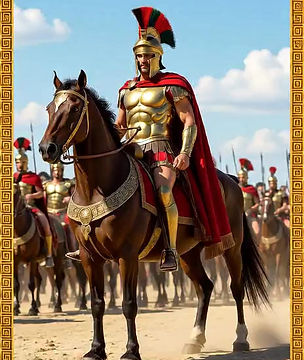




Seleucus Σέλευκος was born in 358 BC, Europos, Makedonia, Greece. His father Antiochus was a lesser nobleman from Europos in Lower Makedonia, of the warrior class of the hetairai of the king Philip II. His mother’s name was Laodice. Seleucus had on his thigh a birthmark in the shape of an anchor. The story explains why the Seleucids used the anchor as a dynastic emblem, e.g. as a counter-mark on coins, and why Apollo was the tutelary deity of the Seleucid family. Seleucus served as a royal page at the court of Philip II, receiving military training and intellectual education together with Philip’s son Alexander, who was about the same age as Seleucus.
After the death of Alexander III of Macedon in 323 B.C., the territories he had conquered were divided between his generals, the so-called Diadochi. Alexander’s friend Seleucus Nicator (r. 312–281 B.C.) became king of the eastern provinces—approximately modern Afghanistan, Iran, Iraq, Syria, and Lebanon, together with parts of Turkey, Armenia, Turkmenistan, Uzbekistan, and Tajikistan. The huge kingdom had two capitals, which Seleucus founded in around 300 B.C.: Antioch in Syria and Seleucia in Mesopotamia (Iraq). Seleucus established a dynasty that lasted for two centuries, during which time Hellenistic art, a fusion of Greek and Near Eastern artistic traditions, developed and flourished.
Department of Ancient Near Eastern Art. “The Seleucid Empire (323–64 B.C.).” In Heilbrunn Timeline of Art History. New York: The Metropolitan Museum of Art, 2000–.

Emperor Seleucus I Nicator
Seleucus I Nikator was an outstanding administrator and enlightened ruler. He founded up to 75 cities, including 16 Antiochus (his father’s name), nine Seleucia, three Apamea, one Stratonicea, five Laodicea; other cities were named after Alexander. In addition, he built many theaters and temples.
"... Among those who took power after Alexander, Seleucus was the greatest man, that he possessed the most royal way of thinking and ruled on the big country after Alexander, this is, without doubt, my opinion"
(Arrian, Anabasis. VII. 22).
"Seleucus, I am convinced, was pious and the fairest man in a relation to religion than all other kings"
(Paus. 1. 16)


The Seleucid Dynasty (Greece), House of Bjelbo (Sweden), House of Grimaldi (Monaco), Clan Hamilton, and Clan Lyon’s (Scotland) descendants have a common ancestor who lived 6000 years ago in the Northern Europe. They have Y-DNA Haplogroup I1.
Seleucid Dynasty
King Antiochus I Soter, 280-261 BC
Khan Shyrdakbek was a prominent ruler and Emir of cities like Andijan, Khojent, Kokand, Kashgar and Jarkend. People in Syria, Turkey, Pakistan and Afghanistan knew his strong fortresses.
Khan Shyrdakbek shared foods and cattle collected from Dzungars’ tribute to the poor people and distributed the extra foods among Tatar, Tajik, Turk, Karakalpak, and Khakas peoples.
Khan Shyrdakbek educated and trained 12 years old girl Janyl until she grew up. Janyl mirza became a leader of Noygut tribe and an epic poem hero too.
Khan Shyrdakbek, his father Sayid Bek, and grandfather Kurban Bek were Kings. They are Epic heroes of the Kyrgyz people. All three Kings are descendants of Emperor Seleucus I Nicator.
The Seleucid Dynasty and its Descendants is the only European aristocracy that lives from the 4th century BC to the 21st century AD in Asia.
Empress of India
Daughter of Emperor
Seleucus I Nicator
Little known facts about Seleucus:
Seleucus was an Admiral in the army of King Ptolemy I in Egypt before he became King of Babylon. He commanded a fleet of 100 ships. They defeated enemies in all the battles.
Seleucus was a very strong man. According to one legend, during a sacred ceremony, a rampaging bull got loose from its rope and began to rumble around the crowd and people began to run away. Seleucus took the rampaging bull by the horns and subdued him. And since then, the expression "Taking the bull by the horns" still exists today.
Hellenic Empire in Asia

Cleopatra










